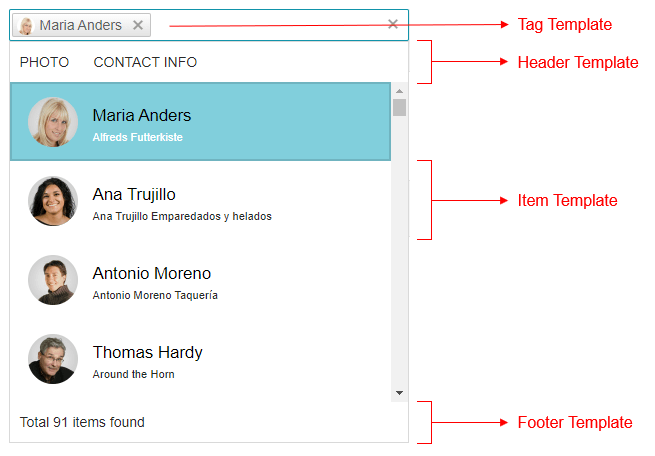Templates
RadMultiSelect uses Kendo UI Templates to provide full control over the rendering of items, selected values, and popup headers. The control supports the following templates:
Figure 1: Structure of the popup and where you can use templates.

You can see the source code used for producing the image in RadMultiSelect Templates Live demo.
Example 1: Sample use of templates in RadMultiSelect.
<telerik:RadMultiSelect runat="server" Width="400px" ID="RadMultiSelect1"
DataTextField="ContactName"
DataValueField="CustomerID"
DropDownHeight="400"
CssClass="customers-wrapper"
Placeholder="Select customers...">
<ItemTemplate>
<span class="k-state-default"><h3>#: data.ContactName #</h3><p>#: data.CompanyName #</p></span>
</ItemTemplate>
<TagTemplate>
<span style="color:red;">#:data.ContactName#</span>
</TagTemplate>
<HeaderTemplate>
<div style="color: darkgreen; font-size: 18px">
<span>Photo</span>
<span>Contact info</span>
</div>
</HeaderTemplate>
<FooterTemplate>
<div style="color: gray; font-size: 14px">
Total #: instance.dataSource.total() # items found
</div>
</FooterTemplate>
<NoDataTemplate>
No data found. Please try searching for a different customer.
</NoDataTemplate>
<WebServiceClientDataSource>
<WebServiceSettings ServiceType="OData">
<Select DataType="JSONP" Url="https://demos.telerik.com/kendo-ui/service/Northwind.svc/Customers" />
</WebServiceSettings>
</WebServiceClientDataSource>
</telerik:RadMultiSelect>
When RadMultiSelect is bound on the server-side, you can add custom attributes in the ItemDataBound event that can be accessed in the templates through the attributes parameter:
<telerik:RadMultiSelect ID="RadMultiSelect1" runat="server" Filter="contains"
DataTextField="Name" DataValueField="ID" OnItemDataBound="RadMultiSelect1_ItemDataBound">
<ItemTemplate>
<span>#:attributes.myAttribute#</span>
</ItemTemplate>
</telerik:RadMultiSelect>
protected void Page_Load(object sender, EventArgs e)
{
if (!IsPostBack)
{
RadMultiSelect1.DataSource = Enumerable.Range(1, 10).Select(x => new MyCustomItem()
{
ID = x,
Name = "Name #" + x
});
RadMultiSelect1.DataBind();
}
}
protected void RadMultiSelect1_ItemDataBound(object sender, Telerik.Web.UI.RadMultiSelectItemEventArgs e)
{
e.Item.Attributes.Add("myAttribute", "Attribute " + e.Item.Value);
}
public class MyCustomItem
{
public int ID { get; set; }
public string Name { get; set; }
}
Protected Sub Page_Load(ByVal sender As Object, ByVal e As EventArgs)
If Not IsPostBack Then
RadMultiSelect1.DataSource = Enumerable.Range(1, 10).[Select](Function(x) New MyCustomItem() With {
.ID = x,
.Name = "Name #" & x
})
RadMultiSelect1.DataBind()
End If
End Sub
Protected Sub RadMultiSelect1_ItemDataBound(ByVal sender As Object, ByVal e As Telerik.Web.UI.RadMultiSelectItemEventArgs)
e.Item.Attributes.Add("myAttribute", "Attribute " & e.Item.Value)
End Sub
Public Class MyCustomItem
Public Property ID As Integer
Public Property Name As String
End Class
Item template
This is the template that is rendered in each individual column. It receives the data parameter that points to the dataItem for the corresponding item, so you can use all its data source fields
<telerik:RadMultiSelect runat="server" Width="400px" ID="RadMultiSelect1"
DataTextField="ContactName"
DataValueField="CustomerID">
<ItemTemplate>
<span class="k-state-default" style="background-image: url('https://demos.telerik.com/kendo-ui/content/web/Customers/#:data.CustomerID#.jpg')"></span>
<span class="k-state-default"><h3>#: data.ContactName #</h3><p>#: data.CompanyName #</p></span>
</ItemTemplate>
<WebServiceClientDataSource>
<WebServiceSettings ServiceType="OData">
<Select DataType="JSONP" Url="https://demos.telerik.com/kendo-ui/service/Northwind.svc/Customers" />
</WebServiceSettings>
</WebServiceClientDataSource>
</telerik:RadMultiSelect>
<style>
.RadMultiSelectDropDown .k-item > span:first-child {
width: 50px;
height: 50px;
border-radius: 50%;
background-size: 100%;
background-repeat: no-repeat;
}
</style>
Tag Template
This is the https://docs.telerik.com/kendo-ui/api/javascript/ui/multiselect/configuration/tagtemplate that manages the way the tag of a MultiSelect is rendered. It is not bound to data and is static HTML.
Header Template
A https://docs.telerik.com/kendo-ui/api/javascript/ui/multiselect/configuration/headertemplate that shows above all items. It is not bound to data and is static HTML.
The header content should be wrapped with an HTML tag if it contains more than one element. This is applicable also when header content is just a string/text.
Footer Template
This is the https://docs.telerik.com/kendo-ui/api/javascript/ui/multiselect/configuration/footertemplate used to render the footer. The footer is re-rendered on every change of the Data Source. The context of the footer template is the underlying Kendo Widget itself that you can access through the instance argument.
Group Template
The template for the header of the group that is not the current topmost group. By default the value of the field by which the data is grouped is displayed and it is sent to the template via the data argument.
Fixed Group Template
The template for the current (topmost) group. It renders just below the column headers and uses the current filter field value by default. This value is sent to the template via the data argument.
No Data Template
This template is shown when the data source is empty or the current filter operation returned no results.
When the NoDataTemplate is defined, the MultiSelect always opens the popup element.